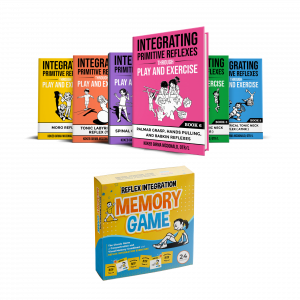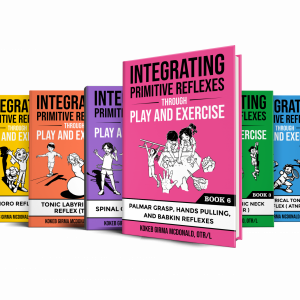When parents first learn that their child has retained primitive reflexes, it can be both a relief (finally, an answer!) and a new source of concern (what now?). Primitive reflexes are automatic movements present in infancy that typically fade as the child grows. When these reflexes are retained beyond the expected age, they can impact physical, emotional, and cognitive development.
If you’ve recently discovered that your child has retained reflexes, this guide is here to provide practical first steps and support for you, the parent, while offering therapists insights on how best to assist families embarking on this journey.
Step 1: Understand What Retained Reflexes Mean for Your Child
For Parents: Gaining a basic understanding of ‘retained reflexes’ is important. When specialists refer to retained reflexes, they mean primary motor reflex patterns that should have naturally faded into the background, becoming foundational building blocks for more voluntary movements and development. However, instead of integrating into the whole body, these reflexes remain active in your child’s body, affecting their coordination and overall development. Examples include the grasp reflex (holding onto an object when it touches their hand) and the rooting reflex (turning the head and opening the mouth when the cheek is stroked). These reflexes typically integrate within the first year of life, with some lasting up to the third year. However, in some children, these reflexes remain active, which can affect coordination, focus, emotional regulation, and even learning.
Take time to learn about the specific reflex patterns that are showing in your child and how they might impact their daily activities and functional skills. Look for resources that explain each reflex in a parent-friendly way so you can understand the connection between these reflexes and your child’s unique challenges.
For Therapists: When introducing retained primary motor reflex patterns to families, ensure the information is accessible and relevant. Avoid jargon and focus on practical explanations: connect specific motor reflex patterns to real-life challenges the child may face, like difficulty with writing or a tendency to become overwhelmed in loud environments. Reassure parents that retained reflexes are not uncommon and that with proper support, progress is possible.
Step 2: Assemble Your Team
For Parents: Consider involving professionals who are knowledgeable in reflex integration, such as occupational therapists (OTs). Occupational therapists with training in reflex integration techniques can be essential partners in this journey.
Start by seeking recommendations or consulting your child’s primary care provider for referrals. When meeting with potential therapists, ask about their experience with retained reflexes and any specific training they have in reflex integration. This will help ensure that you’re working with a professional who understands your child’s needs.
For Therapists: Be ready to answer questions about your experience and approach. Many parents may feel uncertain, and offering clear explanations about the therapy process can make a big difference in their confidence. Also, consider having a list of resources on reflex integration, such as books, websites, or apps, to provide parents with a starting point.

Step 3: Set Realistic Goals and Expectations
For Parents: Reflex integration is not a quick fix; it’s a gradual process that requires consistency. Work with your child’s therapist to set realistic, achievable goals, whether that means improving focus, reducing meltdowns, or enhancing physical coordination. Ask questions like, “What changes might we see first?” and “How long before we notice progress?” This helps you stay motivated and prevents discouragement if progress seems slow.
Celebrate small wins along the way, such as improvements in posture, focus or better hand-eye coordination, as these small changes are positive indicators that your child is moving in the right direction.
For Therapists: Parents may have high expectations for immediate results. Help set realistic timelines and describe how each step in the process builds on the previous one. Keep parents engaged by acknowledging small improvements and reinforcing the positive impacts these changes can have on their child’s daily life.
Step 4: Integrate Reflex Exercises into Daily Routines
For Parents: Many reflex exercises can be simplified into easy, at-home activities that can easily fit into your daily routine. Try incorporating exercises into playtime, like having your child roll like a log or crawl on all fours. These playful activities help activate and integrate the nervous system. No need to feel overwhelmed by all the available exercises; you don’t have to do everything at once. Your therapist will create a customized plan tailored to your child’s specific needs. What matters most is consistency.
Be consistent but flexible. On busy days, opt for shorter exercises or incorporate movements that naturally occur in play. Balance is key—you want exercises to be engaging rather than feeling like a battle. Tracking your child’s progress, even with something as simple as a sticker chart, can be a motivating reminder of their growth.
For Therapists: Provide parents with clear, easy-to-follow, and ready-to-use resources, like the RITP Companion App, to make implementing each exercise simple and minimize the learning curve. These resources should include step-by-step guides, video demonstrations, and visual aids that walk parents through each movement. Suggest ways to incorporate exercises into daily family routines and encourage them to find a rhythm that works for their household. Reassure parents that missed days are okay as long as overall consistency is maintained. U
Step 5: Stay Attuned to Emotional and Behavioral Shifts
For Parents: It’s not unusual for children to experience emotional shifts during reflex integration. Retained reflexes can be deeply rooted in a child’s sense of safety and control. As they work through these patterns, they may experience periods of irritability or sensitivity.
Try to maintain open communication, using gentle language to help your child understand these changes. For example, if they’re more frustrated during tasks, you could say, “I can see this feels tricky today; you’re working hard, and I’m proud of you.”
For Therapists: Help parents understand that reflex integration may come with temporary emotional or behavioral shifts. Explain that this is often a sign that the exercises are working, as the body adjusts to new patterns. Offer strategies for supporting their child during these times, such as grounding techniques, relaxation exercises, and validating their child’s feelings.
Step 6: Engage in a Support Community
For Parents: Connecting with other parents can be a valuable source of support. Look for communities, groups, or local meet-ups focused on reflex integration and child development. Here, you can share experiences, celebrate progress, and exchange tips with others who understand your journey.
For extra guidance, explore educational resources such as workshops or online courses focused on reflex integration. Learning alongside other parents can strengthen your understanding and provide added motivation. Our Family Support Bundle is a great way to get started!
For Therapists: Encourage families to seek out support networks. Provide recommendations for trustworthy groups or communities, especially if they’re specific to reflex integration.
Step 7: Be Patient with the Journey
For Parents: Every child progresses at their own pace, so remember that your child’s journey is unique. Staying patient, practicing exercises regularly, and keeping a positive outlook can help both you and your child enjoy this process.
If you ever feel uncertain or have questions, don’t hesitate to reach out to us and your child’s therapist. Communication is key, and therapists are there to guide and support you every step of the way.
For Therapists: Remind parents to be patient and gentle with themselves as they support their child. Reinforce that, though reflex integration can be a gradual process, even small steps are significant. Provide regular feedback, encouragement, and acknowledgment of the family’s hard work to keep motivation high.
Navigating your child’s developmental journey can be challenging but also deeply rewarding. With the right support, parents can help their children build a solid foundation for growth in coordination, learning, and emotional well-being. Remember, reflex integration is one of many valuable treatment approaches to support foundational development, and each step forward—no matter how small—brings your child closer to reaching their full potential.
Lastly, for therapists: seek ongoing support, mentorship, and specialized training to continually advance your clinical skills and refine your treatment planning. Engaging in professional development not only enhances your ability to support families effectively but also keeps you updated on best practices and innovative approaches. Remember, our understanding of the human body and brain is ever-evolving; staying open-minded and committed to learning enriches both your professional journey and the lives of the families you serve.
For a comprehensive and in-depth training experience, consider joining our RITP Certification Program, designed to equip you with the tools, strategies, and support network you need to make a lasting impact.





